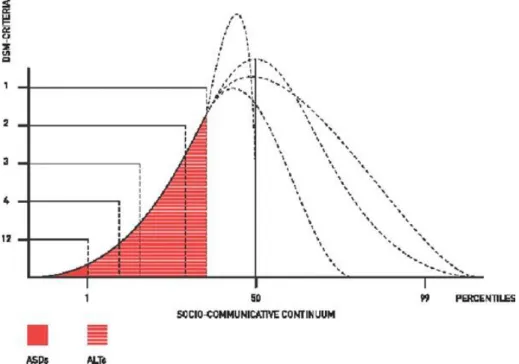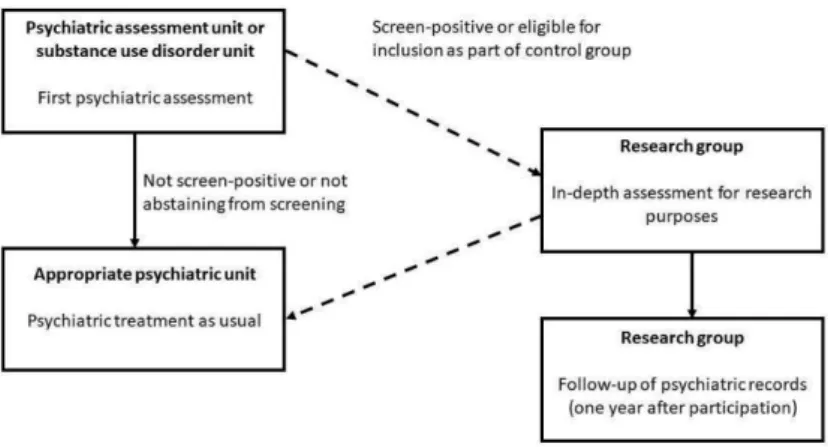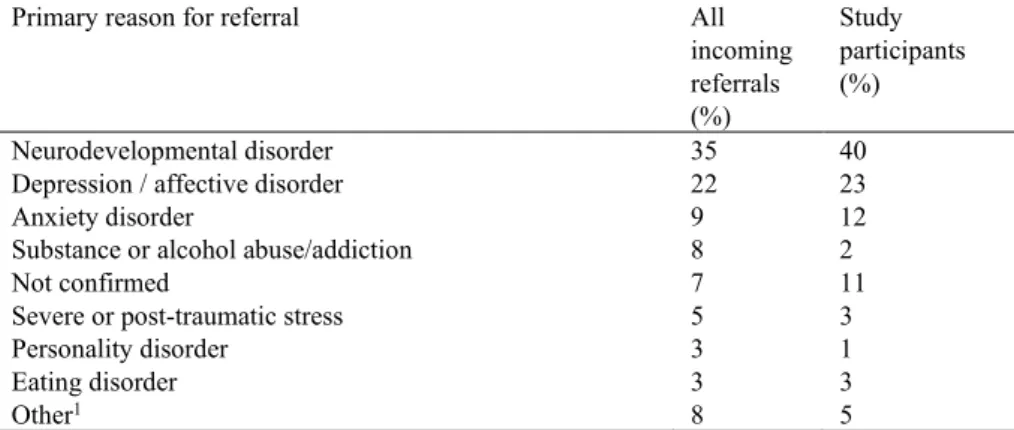The prevalence of ASD in adult psychiatric outpatient services is not known, and adult psychiatric outpatients with ASD are often not investigated. There is also a lack of consensus regarding the prevalence of ASD in adult psychiatric populations.
Autism Spectrum Disorder
Autism-like features (ALT)—symptoms of ASD but not to the extent where a diagnosis is warranted—are common in the general population, although at lower levels than in ASD populations (Lundström et al., 2011; Posserud et al., 2006; Ruzich, 2015), shown below in Figure 1. Previously (at the end of the 20th century), genetic components or heredity were believed to account for almost all cases of ASD (Bailey et al., 1995).

The development of the autism concept
The diagnostic criteria in DSM-III were narrow and inflexible; the definition of autism in the revised version (DSM-III-R) (American Psychiatric Association, 1987) that came a few years later was more flexible and expanded the concept of autism (Volkmar & McPartland, 2014; Wolff, 2004). The increase in autism prevalence rates is not solely attributable to the expansion of the concept of autism or changes in diagnostic criteria.
Co-occurring conditions
The prevalence of eating disorders is more coherently estimated at about 5% (Hofvander et al., 2009; Lugnegard et al., 2011). Individuals (of all ages) with ASD without concurrent ID are believed to be at a four to fourteen times higher risk (women and those with concurrent ADHD present the higher estimates) of suicide attempts and completed suicides than the general population (Hirvikoski et al. al., 2020; Hirvikoski et al., 2016).
ASD and cognition
Poorly developed executive functions in individuals with ASD have been suggested by clinical experience, but it is not clear whether there are ASD-specific executive function impairments (Coleman & Gillberg, 2012). Children and adolescents with ASD show impairments in working memory, inhibition, planning, organization, and flexibility (Dawson, 1996; Kenworthy et al., 2008). Low processing speed has also been demonstrated in children and adolescents with ASD (Linnenbank et al., 2021).
All studies published regarding executive functions in adults with ASD use self- or informant ratings such as the Behavior Rating Inventory of Executive Functioning – Adult version (BRIEF-A; Roth et al., 2005). There is general agreement that young children with ASD have serious problems with "theory of mind" (Coleman & Gillberg, 2012).
Interventions and treatments
In general, individuals with ASD appear to have a tendency toward detail-focused information processing, as opposed to processing styles that focus on more global or universal concepts. Any role of sensory abnormalities in the cognitive development of individuals with attribution disorders is unclear. Knowledge of the treatment of co-occurring psychiatric conditions in adults with ASD is emerging, but published studies are severely lacking.
Descriptions of how to adapt CBT for adults with ASD are rare and generally limited to the works of a few experts (e.g. Gaus, 2018). Clinical trials of CBT or CBT-related psychotherapies for adults with ASD are generally few and with small sample sizes.
Outcome
Functional level (here synonymous with adaptive function, adaptive behavior and/or activities of daily living) is suboptimal in ASD and has consistently been shown to decline with age, at least until early adulthood (Chatham et al., 2018; Tillmann). et al., 2019). Deficits at the functional level, unlike cognitive deficits, are quite uniform in adults with ASD (Chatham et al., 2018). This gap between IQ and functional level in individuals with ASD has been shown to persist into adulthood (Kraper et al., 2017).
Common quality of life - associated parameters such as (self-rated) quality of social relationships, subjective well-being, emotional harmony and perceived health, have recently been shown to be lower in adults with ASD compared to the general population (Graham Holmes et al., 2020). Previous studies (in which a majority of study participants had co-occurring ID) have shown less favorable outcomes in terms of educational or occupational status, but at the same time favorable (self-rated) subjective well-being (Billstedt et al., 2011).
Diagnostics
Specificity appears to decline further when diagnostic tools are used in psychiatric populations (Wigham et al., 2019). Reported sensitivity and specificity of commonly used screening tools for ASD in adults. Overt symptoms of ASD in adults (for example repetitive and/or rigid behaviors, difficulties in social interactions, lack of social motivation, etc.) are associated with many (often overlapping) psychiatric disorders and are commonly observed in psychiatric patients in generally (Bejerot & Nylander, 2022).
Although not empirically investigated, these clinical observations may at least partially explain the lower validity of diagnostic instruments for ASD in psychiatric adults. Although not empirically investigated, these clinical observations may at least partially explain the lower validity of diagnostic instruments for ASD in psychiatric adults.

Context
The overall aim of this thesis was to describe patients with ASD in an adult psychiatric outpatient clinic. In studies I, II and III, that time was at the time of participants' first appointments at an adult outpatient psychiatric service. In Study IV, it was at the time of clinical neurodevelopmental examinations of the participants.
In studies I, II, and III, that time was when participants first made an appointment with an adult outpatient psychiatric service. In study IV, it was at the time of clinical neurological examinations of the participants.
Study I, II and III
All incoming outpatient referrals to the clinic are assessed at one unit – the Psychiatric Assessment Unit (PAU). The cut-off point was set at 50 (the score ranges from 0 to 240), which is lower than recommended in clinical applications in Swedish contexts (72) (Andersen et al., 2011). The size of the RAADS-R (80 items) discouraged many patients from participating in the screening (and was one reason for initial failures to implement systematic screening).
The FTF (Kadesjo et al., 2004) was forwarded by the participants to their parents for completion. The joint validations were conducted as longitudinal expert discussions using all data (LEAD) (Kranzler et al., 1994).

Study IV
Between 2010 and 2017, patients from all units in the clinic with suspected NDD were referred to this specialist team for NDD evaluation. Eight of the participants were assigned additional diagnoses of attention disorders; three combined-type ADHD, one inattentive-type ADHD, and four attention deficit disorders - not otherwise specified. None of the participants worked full-time; 2 were working part-time, 6 were studying and 22 were unemployed with social benefits.
Two of the participants were assessed with the Wechsler Adult Intelligence Scale-Third Edition (WAIS-III) (Wechsler, 1997), which has a similar structure to the WAIS-IV. The Color-Word Interference Test (CWIT) is a variant of the classic “Stroop” test (Stroop, 1935), which requires the participant to read a sheet of color names printed in the “wrong” color.
Analysis and statistical methods used, by study
Between-group comparisons of continuous and normally distributed variables were performed using Student's t -test and analyzes of variance (ANOVA). Comparisons between groups in nominal variables were performed using Chi-square tests or Fisher's exact test (in 2x2 tables). Linear regression analyzes were performed to explore the relationship between the outcome variable (GAF) and potential predictors.
Comparisons between groups were performed with Mann-Whitney U-test or Student's t-test (for continuous variables, depending on whether the variables were normally distributed). Pearson correlation analyzes were performed between the different ABAS-II domains, the GAC and the results from all cognitive and executive function tests.
Ethics
Study I
The fourth test used in this study was the Proverb test where the participant has to explain and explain eight different sayings. The participant must first freely explain the theorem, and then in the optional condition.
Study II
Comparisons of age and gender between screening responders and non-responders were performed; comparisons of other variables involving the non-responders were limited by ethical permissions. Comparisons were also made between the ASD group, the subthreshold ASD group, the non-ASD group, and the screen-positive nonparticipant group in terms of age, sex, RAADS-14 scores, ASDI scores, IQ estimate, and GAF - score. Due to similarities in the degree of autism symptomatology, the ASD group and the subthreshold ASD group were collapsed into a "Merged ASD" group, intended to cover the broad autism phenotype.
Between-group comparisons were then made between the merged ASD group and the non-ASD group. Correlation analyzes between GAF and potentially associated factors were performed using Spearman's rho, as all independent variables were not normally distributed.
Study III
Study IV
Known risk factors for NSSI were analyzed in the study sample as potentially associated with NSSI. Psychiatric co-occurring conditions in the pooled ASD group by DSM-5 category, in order of prevalence, were: NDDs other than ASD (90%; of which 67% had ADHD of any subtype); Anxiety disorders (87%); OCD and related disorders (53%), depressive disorders (40%); potential SUD (hazardous or harmful alcohol use and/or drug-related problems) (30%); bipolar disorders (29%); trauma and stressor-related disorders (21%); disruptive, impulse control and conduct disorders (11%); eating disorders (10%); and schizophrenia spectrum and other psychotic disorders (5%). Psychiatric profiles for the two groups were similar, but anxiety disorders and NDDs (other than ASD) were more common in the pooled ASD group.
This study explored suicidal ideation, plans, and attempts, as well as NSSI, in the merged ASD group (n = 63). Trends in the data showed that PRI from WAIS was higher than VCI, WMI and PSI.
Prevalence of ASD in adult outpatient psychiatry
Three of the four measures of executive function were in the mean range, only the Proverb test was below mean. The trends in the data further showed that all tests of executive function except verbal fluency, condition 2 (word generation in concrete categories), were below average. Even if one were to be extremely careful and assume that every patient with ASD participated in the study during the screening period, the prevalence of ASD would still be 4.6%, i.e.
In the ASD participants, the symptoms are represented rather than the pattern of symptoms (two to three A criteria and at least two B criteria simultaneously, according to DSM-5) commonly associated with ASD. Only one participant in the entire group studied fulfilled criterion B1 (stereotyped or repetitive motor movements, use of objects or speech).
Similarities and differences compared to non-ID adults with ASD
Validation of two survey methods for identifying cases of autism spectrum disorder in community adults. Psychiatric comorbidity and functioning in a clinically referred population of adults with autism spectrum disorders: a comparative study. Understanding executive control in autism spectrum disorders in the lab and in the real world.
Psychiatric co-occurring symptoms and disorders in young, middle-aged and older adults with autism spectrum disorder. Prevalence of psychiatric disorders in adults with autism spectrum disorder: A systematic review and meta-analysis. Prevalence of school bullying among youth with autism spectrum disorders: a systematic review and meta-analysis.
Patterns of nonsocial and social cognitive functioning in adults with autism spectrum disorder: a systematic review and meta-analysis.
Similarities and differences compared to psychiatric outpatients without
Strengths and limitations
The relationship between restricted and repetitive behaviors and nonverbal IQ in children with autism spectrum disorders. The RAADS-14 screen: validity of a screening tool for autism spectrum disorders in an adult psychiatric population. Medical comorbidities in children and adolescents with autism spectrum disorders and attention deficit hyperactivity disorder: a systematic review.
Ritvo Autism Asperger Diagnostic Scale-Revised (RAADS-R): a scale to aid the diagnosis of autism spectrum disorder in adults: an international validation study. Measuring autistic traits in the general population: a systematic review of the Autism Spectrum Quotient (AQ) in a non-clinical population sample of 6,900 typical male and female adults. Real-world executive functions in adults with autism spectrum disorders: profiles of impairment and associations with adaptive functioning and co-morbid anxiety and depression.
Psychometric properties of questionnaires and diagnostic measures for autism spectrum disorders in adults: a systematic review.

